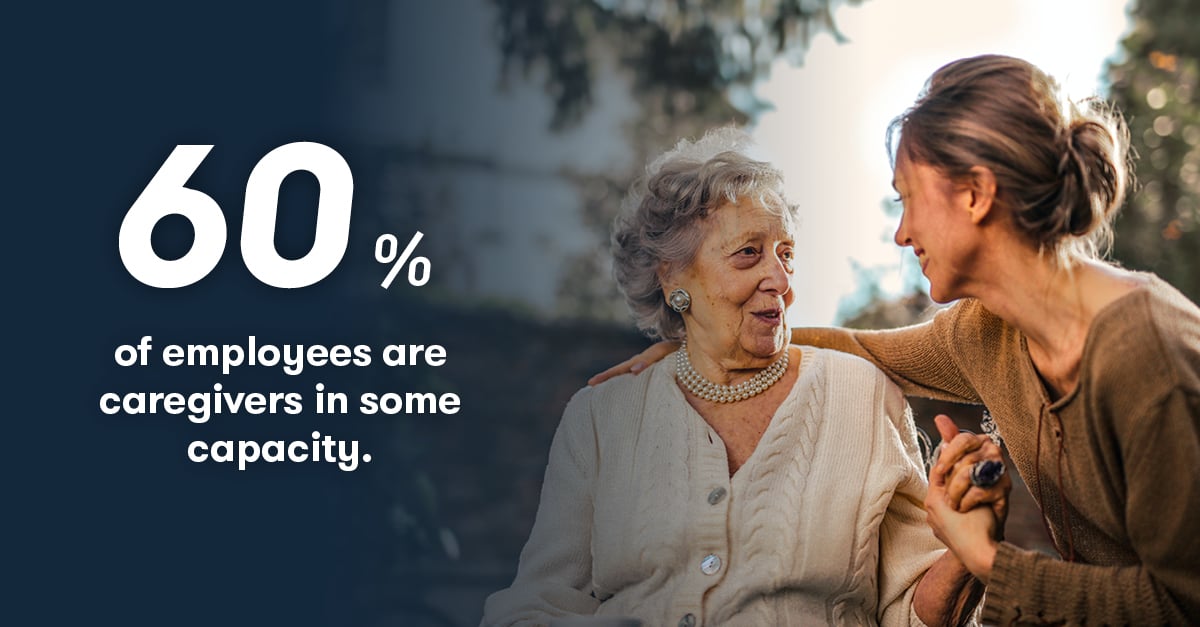Caregiver support doesn’t initially come to mind when employers consider how they can support their employees. But the COVID-19 pandemic turned a typically invisible population of employee caregivers visible. Whether employees cared for family members before the pandemic or as a result of it, it’s clear that employees’ needs changed, as did the type of support they required from their employers.
Why Employers Should Support Employee Caregivers
About 40 million US workers identify as caregivers or someone who provides for a child or an aging adult, which is equal to around 60% of employees. Almost 40% of working Americans fall into the ‘sandwiched’ generation, meaning that just under half of all employees care for their children and aging parents.
Here are a few statistics about employee caregivers to consider:
- 50% of caregivers report not having adequate time to spend with their families.
- 79% of caregiving employees don’t have access to caregiver support benefits at work.
- Caregivers spend roughly nine hours per week taking care of others.
- 73% of caregivers have to leave work early or unexpectedly.
- Absenteeism due to caregiving results in $25 billion annually.
- 52% of caregivers lost income because they had to miss work.
When caregiving employees are supported, they are:
- More productive
- More likely to stay with one company for longer
- More engaged
- More satisfied with their work
- More motivated
When we consider these numbers, implementing caregiver support in the workplace seems like a no-brainer.
In reality, employees don’t leave their personal lives as soon as they walk through the workplace door or sit down in their home offices. Employers that provide resources to help employees manage their personal lives can boost employee engagement and retention efforts.
The Toll of Caregiving
Being a caregiver is no easy feat. It requires time, stamina and resilience.
One in five caregivers reports having constant stress in their lives, while one in four admits the reality of caregiving is emotionally taxing. Caregivers have a higher risk of health issues due to the physical and mental exhaustion caregiving takes. 23% reported a decline in their health due to caregiving.
Besides the stress of ensuring everything at work runs smoothly, caregivers must also be prepared for the unexpected. When a caregiving emergency arises, employees need to be able to be there for their loved ones. When working in an environment that doesn’t have the support or flexibility for these unexpected instances, caregiving becomes much more stressful.
For example, 80% of caregiving employees report productivity losses because of their responsibilities, while 32% explain that they left a job because of its lack of flexibility.
There’s no doubt that the pandemic has changed the way employees work and companies operate. For instance, some employees have minimized their commute while adapting to remote work. But for caregivers, that extra hour they get back in their mornings and evenings is filled with more caregiving responsibilities.
How Employers Can Support Caregivers
Now that there’s a clearer idea of why caregiving employees need support, here’s how employers can step in.
One of the best things employers can do for their employee caregivers is to offer them the chance to work during hours of their choice. This allows them extra time to ensure their own needs and those they care for are met before they begin focusing on work.
As we’ve learned, caregiving isn’t easy and is particularly draining. That’s why employers must focus on offering mental and physical support. In addition to flexibility and mental and emotional health support, employees can take care of the caregivers they have onboard by:
- Consistently showing up for employees with support and empathy.
- Offering benefits like apps or services that help employees find and manage care.
- Understand and promote underutilized aspects of your employee assistance program, including legal, financial, eldercare and childcare resources.
- Research what benefits are available in your state regarding paid family leave on top of the leave afforded by the Family and Medical Leave Act (FMLA).
Supporting caregivers isn’t only good for employees, but it's good for business. A recent report explains that US companies spent over $13.4 billion in healthcare costs due to caregiver-related health issues.
Remember that employees may be apprehensive to tell you about their responsibilities outside of work. While you may be unable to accommodate every situation, ensure employees know your HR team is available to help however they can. Once employers understand what it takes for employees to be excellent caregivers while still engaged at work, employees can feel prepared to do their best work.


